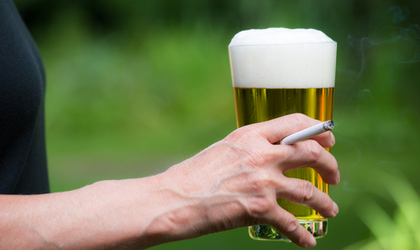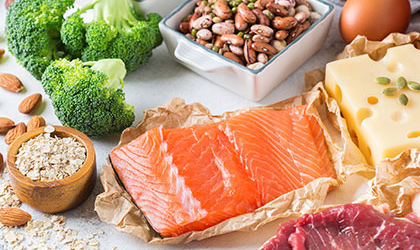
Determining how healthy your bones are is a tough one – after all, 206 of them are hidden under swathes of skin, so it’s pretty hard to find out whether your existing lifestyle choices are having a positive or negative effect. But this isn’t a reason not to keep your eagle eye on bone health. Out of sight doesn’t mean out of mind in this case. Because once you take a tumble and fracture a bone – be it hip, spine, or forearm – it’s usually too late. And though these breakages typically blight the over 65’s, the foundation for such life-changing events is laid much, much earlier. In other words, it’s time to act now. Besides the obvious - family history – further clues about your bone health are a little subtler. Here are the main signs to pay close attention to.
Your gums are receding
When you hear the words ‘bone loss’, gums don’t necessarily spring to mind. But like any other bone in your body, your jawbone – which supports and fastens your teeth – is vulnerable to weakening. If your jawbone loses bone density, your gums may start to recede and detach from your teeth. Losing your teeth is another oral red flag. A review published by the Journal of Dentistry concluded that of the 17 studies analysed, 11 exhibited a positive relationship between reduced bone density and bone loss in the jaw bonei. Another study substantiated these findings, revealing postmenopausal women with poor bone density also experienced compromised dental healthii. Of course, receding gums can have other explanations; neglecting oral hygiene and over-brushing are also likely culprits. However, if you’re experiencing receding gums along with the symptoms outlined below, it’s probably time to bone up on your bone health.
The solution?
Talk to your dentist and discuss any risk factors you may have for poor bone health such as family history, smoking, hormonal health, or nutritional changes. Always ask for an X-ray if anything looks suspicious.
Your nails are prone to chipping
When you’ve laboured over perfecting your fingertips, chipping a nail can be downright annoying. But if your talons are breaking regularly, you shouldn’t ignore it. You see, your digits are small windows into your overall health. And chipped nails may signal your bones are just as brittle. One study proposed individuals with depleted collagen (a strengthening protein) stores in their nails are unlikely to have enough in their bones, eitheriii. Beyond this, weak nails are also symptomatic of declining levels of the bone-supporting mineral, calcium. While brittle nails can often be linked to poor bone health, be mindful they can arise from cosmetic causes, too, such as exposure to harsh detergent or soap, over-washing, or long-term nail polish use.
The solution?
If you’ve chipped one nail too many, a powerful weapon in your bone health arsenal (and nail arsenal, for that matter) is eating more calcium-rich foods. And this doesn’t just mean gulping down glasses of milk. Kale, broccoli, yoghurt, cheese, and sardines are also chock-full of the mineral. Don’t forget vitamin D supports the absorption of calcium, too! Learn more about the importance of vitamin D for bone health here. Embrace a range of vitamin D-rich oily fish (trout, herring, salmon, and mackerel), eggs, lamb’s liver, and other fortified foods, such as orange juice, milk, and bread. In addition to food sources, remember to get enough vitamin D-inducing sunshine in your life, too. Concerned about your intake? Adding a vitamin D supplement (10mcg) to your diet will help cover any nutritional shortfalls. Discover all you need to know about bone-bolstering nutrition here.
You have a high resting heart rate
You may be wondering how on earth this is related to bone health but hear us out. Your resting heart rate (the number of heart beats per minute while your body is inactive) is a useful indicator of your fitness level. For many people, this falls anywhere between 60 and 100 beats per minutes. If you’re resting heartbeat is greater than 80, however, your bone health, amongst other things, might be paying the price. Resting heart rates are typically higher in individuals who have a sedentary lifestyle. And since exercise – particularly weight-bearing activity – is vital for building a healthy frame and strong bones, it’s possible your bones feel a little neglected.
The solution?
First things first, you need to determine your rest heart rate. The best time to do this is as soon as you wake up. Place two fingers over your pulse on your neck or wrist. Set a timer for 15 seconds and count the number of beats within this window. Then, multiply this number by four to decipher your resting heart rate. If that number is 80 or higher, take this as a prompt to move your body more. Though physical activity makes your heart beat faster temporarily, exercising regularly will generate a calmer resting heart rate. Moving your body in any shape or form will benefit your heart, but the emphasis should also be on your bones. For this, we suggest weight-bearing exercise – walking, tennis, running, aerobics, or dancing – since it’s known for cultivating strong, stealthy bones. Learn more about exercising for bone health here.
You struggle to grip things
Do you have a difficulty opening car doors? Do you struggle to push yourself up from a seat? Or perhaps you find it hard picking up a glass? Blame your bones. Data suggests poor handgrip is correlated with overall low bone density. In one study on healthy postmenopausal women, researchers found that lower handgrip was associated with reduced bone mass density in the spine, neck, and hipiv. Women tend to bear the brunt of this problem more since they usually lack upper body strength.
The solution?
Thankfully, improving your handgrip is completely within reach, regardless of your age or gender. The best way to build strength is through resistance training. Never lifted weights before? Always start off light and work your way up. Don’t be afraid to enlist the support of a personal trainer if you need guidance. Yoga is another brilliant tool to bolster strength, and it comes with the added bonus of improving motion, balance, and reflexes (the afterglow is pretty lovely, too!).
References:
-
Esfahanian. V., Shamami. M.S. & Shamami. M.S. (2012). Relationship between osteoporosis and periodontal disease: review of the literature. Journal of Dentistry (Tehran, Iran). ;9(4), 256–264.
-
Henriques. P.S., Pinto Neto. A.M. (2011). Association between tooth loss and bone mineral density in Brazilian postmenopausal women. Journal of Clinical Medicine Research. ;3(3), 118–123.
-
Pillay. I., Lyons. D., German. M., Lawson. N., Pollock. H., Saunders. J., Chowdhury. S., Moran. P. & Towler. M. (2005). The Use of Fingernails as a Means of Assessing Bone Health: A Pilot Study. Journal of Women's Health. ;14(4), 339-344.
-
Kim. S.W., Lee. H.A. & Cho. E.H. (2012). Low handgrip strength is associated with low bone mineral density and fragility fractures in postmenopausal healthy Korean women. Journal of Korean medical science. ;27(7), 744–747.
You Might Also Like

Olivia
Olivia Salter has always been an avid health nut. After graduating from the University of Bristol, she began working for a nutritional consultancy where she discovered her passion for all things wellness-related. There, she executed much of the company’s content marketing strategy and found her niche in health writing, publishing articles in Women’s Health, Mind Body Green, Thrive and Psychologies.
View More



